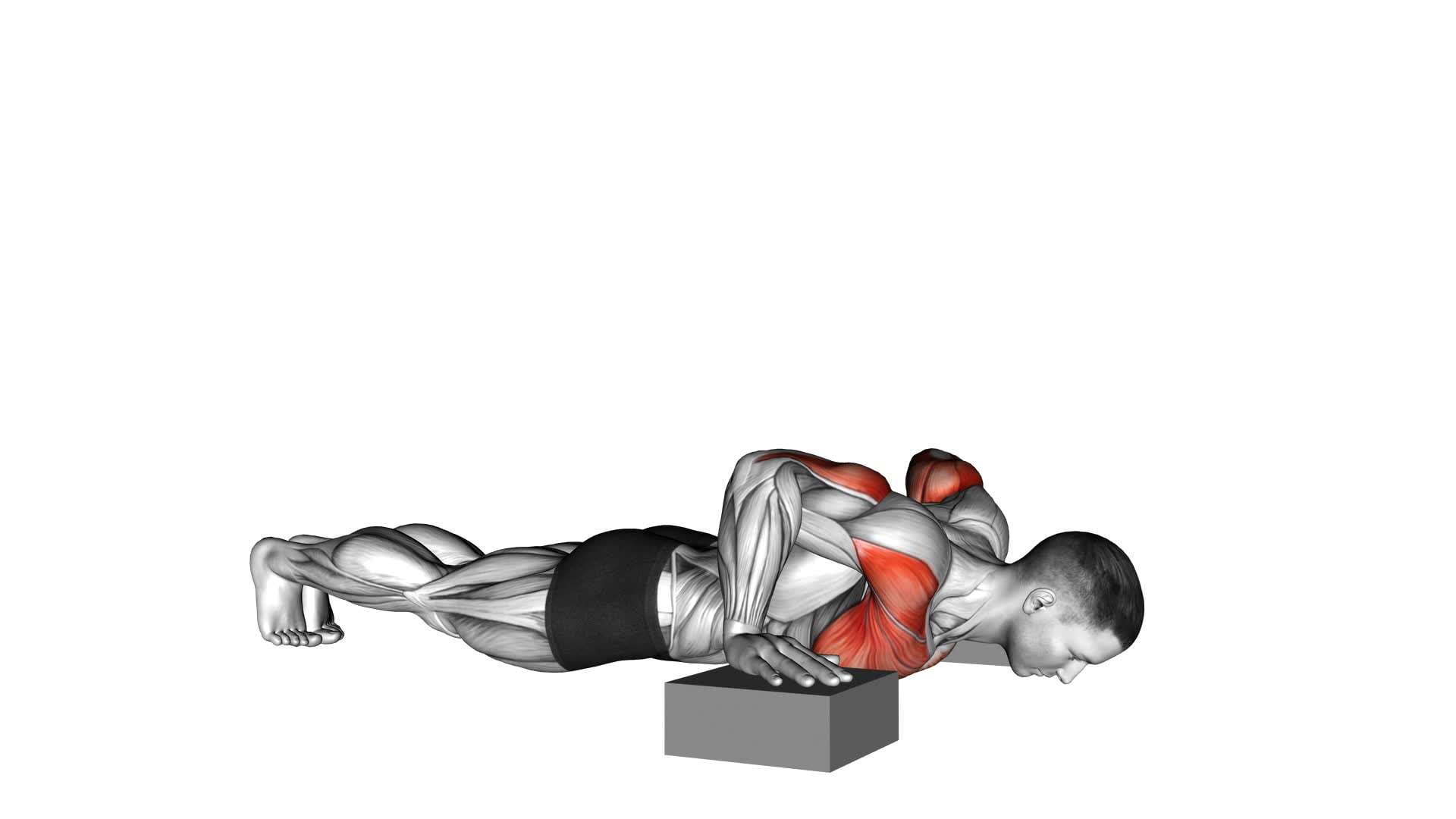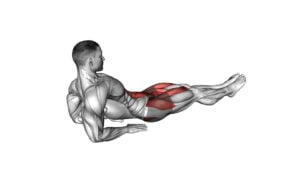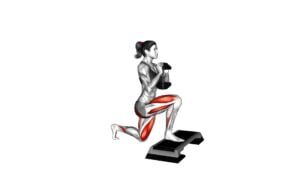Elevanted Push-Up – Video Exercise Guide & Tips

Looking to take your push-up game to the next level? Elevate your workout with the elevated push-up!
Watch This Exercise Video
This video exercise guide and tips will show you the proper form and technique, variations and progressions, and common mistakes to avoid.
Targeting multiple muscle groups, this challenging workout will help you build strength and improve your overall fitness.
Get ready to feel the burn and achieve your fitness goals with the elevated push-up.
Let's get started!
Key Takeaways
- Elevated push-ups increase upper body strength and improve muscle activation.
- Proper form and technique include focusing on breathing, engaging core muscles, and preventing lower back sagging.
- Variations and progressions like one-arm push-ups and modified push-ups for beginners add variety and challenge to workouts.
- Common mistakes to avoid include maintaining a straight line from head to heels, proper breathing techniques, and focusing on core stability for proper alignment.
Benefits of Elevated Push-Ups
You can experience increased upper body strength and muscle activation by incorporating elevated push-ups into your workout routine. Elevated push-ups, also known as incline push-ups, are a variation of the traditional push-up exercise where your hands are placed on an elevated surface, such as a bench or a step. This modification changes the angle of your body and increases the intensity of the exercise.
Compared to regular push-ups, elevated push-ups target your chest, shoulders, and triceps more effectively. The elevated position allows for a greater range of motion, enabling your muscles to work harder. This increased muscle activation leads to improved upper body strength and development.
Incorporating elevated push-ups into your workout routine is relatively simple. You can start by placing your hands on an elevated surface, such as a bench or a sturdy step, and assuming a push-up position. Lower your body down towards the surface, keeping your core engaged and your elbows close to your body. Push yourself back up to the starting position. Repeat for the desired number of repetitions.
Proper Form and Technique
How can you ensure proper form and technique while performing elevated push-ups?
To achieve proper form and technique during elevated push-ups, it's essential to focus on two key elements: breathing techniques and core engagement.
Firstly, correct breathing techniques are crucial for maintaining stability and maximizing the effectiveness of this exercise. As you lower your body towards the elevated surface, inhale deeply through your nose. This helps to stabilize your core and maintain proper alignment. As you push back up, exhale forcefully through your mouth, engaging your abdominal muscles and generating power.
Secondly, core engagement is vital for maintaining a stable and strong body position throughout the exercise. Before you begin the movement, engage your core muscles by contracting your abdominal muscles and pulling your belly button towards your spine. This will help to stabilize your torso and prevent your lower back from sagging.
Variations and Progressions
Let's explore advanced progressions for push-ups, modifying them for beginners, and the benefits of push-up variations.
By incorporating advanced progressions, such as the one-arm push-up or the weighted push-up, you can challenge your strength and further develop your muscles.
For beginners, modifying push-ups by performing them on an elevated surface or using knee push-ups can help build foundational strength.
Additionally, experimenting with different variations, like wide grip or diamond push-ups, can target different muscle groups and add variety to your workout routine.
Advanced Progressions for Push-Ups
Explore advanced variations and progressions of push-ups to challenge your upper body strength and take your workout to the next level.
These advanced modifications and techniques can help you continue to build muscle and improve your overall fitness.
One advanced variation is the diamond push-up, where you place your hands close together in the shape of a diamond. This places more emphasis on your triceps, making it a challenging variation.
Another advanced technique is the one-arm push-up, where you perform a push-up while balancing on one arm. This requires significant core strength and stability.
By incorporating these advanced progressions into your push-up routine, you can continue to challenge yourself and see continued improvements in your strength and fitness.
Now, let's explore modifying push-ups for beginners to ensure everyone can benefit from this effective exercise.
Modifying Push-Ups for Beginners
To modify push-ups for beginners, start with an elevated push-up. This variation allows you to build strength gradually while maintaining proper form. Find a sturdy surface, like a bench or step, and place your hands shoulder-width apart on the elevated surface.
Keep your body in a straight line from head to toe, engage your core, and lower yourself down until your chest is just above the elevated surface. Push yourself back up to the starting position.
This modification reduces the amount of weight you're pushing, making it easier for beginners to perform the exercise. It's also a great option for seniors or pregnant women who may need to modify push-ups to accommodate their physical abilities or limitations.
Remember to listen to your body and progress at your own pace.
Benefits of Push-Up Variations
As you progress from modifying push-ups for beginners, you can continue to challenge yourself and reap the benefits of push-up variations and progressions.
One of the effective ways to elevate the difficulty level is by incorporating elevated push-up variations. By placing your hands on a bench, step, or platform, you increase the range of motion and engage your muscles even more.
Additionally, different push-up techniques, such as diamond push-ups, wide grip push-ups, and decline push-ups, target specific muscle groups and add variety to your workout routine. These variations help to build upper body strength, improve core stability, and enhance overall muscle definition.
By consistently incorporating different push-up techniques, you can continuously challenge your muscles and achieve better results.
Now, let's explore some common mistakes to avoid to ensure proper form and effectiveness in your push-up variations.
Common Mistakes to Avoid
When performing elevated push-ups, it's important to focus on proper form techniques to maximize the effectiveness of the exercise. Make sure to maintain a straight line from your head to your heels and avoid sagging or arching your back.
Additionally, pay attention to your breathing during the exercise, exhaling as you push up and inhaling as you lower yourself down.
Lastly, don't underestimate the importance of core stability in performing elevated push-ups correctly, as a strong core helps to maintain the proper alignment throughout the movement.
Proper Form Techniques
Are you executing the Elevated Push-Up correctly? Proper form techniques are crucial to ensure you get the most out of this exercise. Let's start with breathing techniques.
Many people tend to hold their breath while performing push-ups, but this can lead to unnecessary strain and fatigue. Instead, remember to inhale as you lower your body and exhale as you push back up.
Now, let's discuss some common mistakes to avoid. One of the most frequent errors is sagging or arching the back. To maintain proper form, engage your core muscles and keep your body in a straight line from head to heels.
Another common mistake is flaring the elbows out to the sides, which puts excessive stress on the shoulders. Instead, keep your elbows tucked in close to your body to protect your joints.
Breathing During Exercise
To ensure you get the most out of your Elevated Push-Up, it's important to focus on your breathing technique and avoid common mistakes.
Proper breathing techniques can enhance your performance and help you maintain control throughout the exercise. One common mistake to avoid is holding your breath during the movement. This can lead to increased tension in your muscles and reduce your overall strength.
Instead, practice breath control during exercise by inhaling deeply before lowering your body and exhaling as you push yourself back up. This rhythmic breathing pattern helps oxygenate your muscles and maintain stability. By mastering your breath, you can optimize your performance and prevent unnecessary strain.
Now, let's delve into the importance of core stability for a successful Elevated Push-Up.
Importance of Core Stability
Maintain proper core stability to maximize the benefits of your Elevated Push-Up and avoid common mistakes.
Core strength is crucial for overall stability and balance during exercise. By engaging your core muscles, you create a solid foundation for movement and prevent injury. Stability training focuses on strengthening the muscles in your abdomen, lower back, and pelvis, which are essential for maintaining proper alignment and control. Neglecting core stability can lead to poor form and decreased effectiveness of the Elevated Push-Up.
To ensure proper core engagement, focus on drawing your belly button towards your spine and maintaining a neutral spine position throughout the exercise. By prioritizing core stability, you'll enhance your performance and reap the full rewards of the Elevated Push-Up.
Now, let's dive into the targeted muscles and benefits of this exercise.
Targeted Muscles and Benefits
Engage your chest, shoulders, and triceps while reaping the benefits of an elevated push-up. This exercise targets multiple muscle groups and offers a range of benefits for your overall fitness. Here's what you can expect from incorporating elevated push-ups into your workout routine:
- Chest: The primary muscle worked during elevated push-ups is the chest, specifically the pectoralis major. This exercise helps to strengthen and tone your chest muscles, leading to improved upper body strength and a more defined appearance.
- Shoulders: As you lower and raise your body during elevated push-ups, your shoulder muscles, particularly the deltoids, are engaged. This exercise helps to develop strong and stable shoulders, enhancing your upper body functionality and reducing the risk of shoulder injuries.
- Triceps: The triceps, located at the back of your upper arms, are heavily involved in the pushing motion of elevated push-ups. Regularly performing this exercise helps to tone and strengthen your triceps, contributing to overall arm strength and definition.
- Core Stability: While the primary focus of elevated push-ups is on the upper body, this exercise also requires core stabilization. Your abdominal muscles, along with the muscles of the lower back, work to maintain proper alignment and stabilize your body throughout the movement.
Tips for a More Challenging Workout
To make your workout more challenging, try incorporating these tips into your elevated push-up routine.
There are several modifications you can try to increase the difficulty of your workout. One challenging modification is to perform your push-ups with your feet elevated on a stable surface such as a bench or step. This will increase the angle of your body, putting more weight on your upper body and making the exercise more challenging.
Another modification is to use a stability ball under your feet instead of a bench or step. This will require more core stability and balance, making the exercise even more difficult.
In addition to challenging modifications, there are also equipment recommendations that can help make your elevated push-up routine more challenging. Using resistance bands is a great way to add difficulty to your push-ups. Attach the bands to a stable surface and loop them around your body as you perform the exercise. This will add resistance and make your muscles work harder.
Another equipment recommendation is to use a weighted vest. Wearing a weighted vest will increase the load on your muscles, making the push-ups more challenging and effective. Remember to start with a weight that's appropriate for your fitness level and gradually increase as you get stronger.
Frequently Asked Questions
How Many Elevated Push-Ups Should I Do in a Workout Session?
To determine how many elevated push-ups to do in a workout session, consider your fitness level and goals. Start with a manageable number and gradually increase as you get stronger. Incorporating variations like placing your feet on a higher platform or adding a weighted vest can increase difficulty.
Elevated push-ups engage multiple muscles and help build upper body strength. Including them in a full body workout can enhance overall muscle development and improve core stability.
Can Elevated Push-Ups Help Me Lose Weight?
Elevated push-ups can definitely aid in weight loss. By incorporating them into your workout routine, you'll not only be toning your muscles but also burning calories.
These push-ups target your upper body, specifically your chest, shoulders, and triceps. The elevated position increases the intensity of the exercise, making it more effective for building strength and burning fat.
Are Elevated Push-Ups Suitable for Beginners?
Elevated push-ups can be a great exercise for beginners. By modifying the movement, you can make it more accessible and less intimidating.
The benefits of elevated push-ups include building upper body strength, targeting the chest, shoulders, and triceps, and improving core stability.
Starting with a higher surface, like a bench or step, allows you to gradually increase the difficulty as you get stronger.
Remember to maintain proper form and listen to your body to avoid injury.
Can Elevated Push-Ups Help Improve My Posture?
Elevated push-ups can indeed help improve your posture. By engaging your upper body muscles, they promote improved upper body strength. Additionally, elevated push-ups activate your core muscles, leading to benefits for core stability.
Performing this exercise regularly can help correct rounded shoulders and strengthen your back muscles, resulting in better posture. Incorporating elevated push-ups into your workout routine won't only enhance your overall strength but also contribute to better posture and body alignment.
How Often Should I Incorporate Elevated Push-Ups Into My Exercise Routine?
To determine the frequency of incorporating elevated push-ups into your exercise routine, consider your current fitness level and goals. If you're a beginner, start with 2-3 times per week and gradually increase as you become stronger. More experienced individuals can aim for 3-4 times per week.
Incorporating elevated push-ups has numerous benefits, such as strengthening your upper body, core, and improving posture. Remember to listen to your body and adjust the frequency as needed.
Conclusion
In conclusion, elevated push-ups are a highly effective exercise that target multiple muscle groups and provide numerous benefits. By utilizing proper form and technique, variations and progressions can be incorporated to continually challenge and improve your strength.
However, it's important to avoid common mistakes to prevent injury and maximize results. With these tips in mind, you can enhance your workout and achieve optimal results with elevated push-ups.

Author
Years ago, the spark of my life’s passion ignited in my mind the moment I stepped into the local gym for the first time. The inaugural bead of perspiration, the initial endeavor, the very first surge of endorphins, and a sense of pride that washed over me post-workout marked the beginning of my deep-seated interest in strength sports, fitness, and sports nutrition. This very curiosity blossomed rapidly into a profound fascination, propelling me to earn a Master’s degree in Physical Education from the Academy of Physical Education in Krakow, followed by a Sports Manager diploma from the Jagiellonian University. My journey of growth led me to gain more specialized qualifications, such as being a certified personal trainer with a focus on sports dietetics, a lifeguard, and an instructor for wellness and corrective gymnastics. Theoretical knowledge paired seamlessly with practical experience, reinforcing my belief that the transformation of individuals under my guidance was also a reflection of my personal growth. This belief holds true even today. Each day, I strive to push the boundaries and explore new realms. These realms gently elevate me to greater heights. The unique combination of passion for my field and the continuous quest for growth fuels my drive to break new ground.







